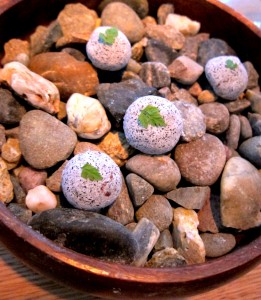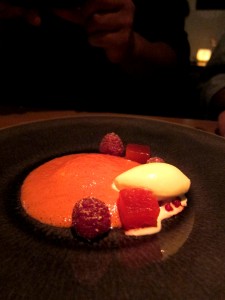
The difference between a bowl of ramyeon at Gomnaru and a six-course dinner at Commis is the ratio of satisfaction to expectation. This is how I rank my foods, which allows me to enjoy a Cheetos just as much as any prime ribs done well, perhaps even more. There are certain extremes, like the cafeteria at Berkeley and LBL, no matter how low I set my bar, they manage to wow me with their ability to ruin everything, including fried rice. Anyhow, I figured that it’s only respectful to the chefs that I go to a well applauded, top ranking restaurant with high expectation. But for Commis, I think my expectation was a bit too high.
The ingredients: fresh, interesting, nothing to complain about. The techniques: nothing I know enough to comment about. The combinations: hmm… An hour after dinner, Rob asked me: “How would you describe your dinner tonight in four sentences?” “Four?” “Three. Ask me again and I’ll say two.” The truth is I would rather sum it up in one: “I don’t remember”.
I can remember vividly the banh mi a vendor sold in front of my high school ten years back, the way its charred meatballs melted in my mouth, its yellow mayonnaise, its crumbs broke free into the motobike-exhaust-filled air. I can remember equally vividly the chicken crepe I bought a rainy night in Seattle four years back, the running warmth of its cheese, its springy softness, my frozen fingers. Just how was the poached egg, or the soup, or the dessert at Commis last Wednesday night? I can’t even remember what’s in the soup.

For every course, like at any fine restaurant, our hostess arrived with a gently toned, slurred-together string of ingredients, of which I could hear the first and the last words and consonants in between. I am not skilled enough to detect a sprinkle of tarragon just by tasting, so I base my judgement on the harmony. Scallop-like monkfish paired with grainy beans was the most discordant in texture, and its accompanying sauce was a bit too fishy and too salty. The opening cookie excited us in its rock-like appearance but hit a dry tune, I suspect a pebble size would be more palatable. The ending nectarine jelly invited little attention and tasted too sweet. Intermittently flared a few high notes, such as the dill weed‘s tanginess in a cauliflower-potato-salad combo, or the pistachio sauce tightened with a radish zest of horsegrass (one of these days I will find it on Google).

The most memorable piece of the night was a cucumber, green apple, and eucalyptus palate-cleanser. It was what it sounds like: a sorbet. The cucumber made a profound impression. I would trade the whole dinner for another shot glass of this. But the sorbet alone does not make the meal worth its hundred dollar value or make it stand out.
It was neither too good nor too bad. It was like a landscape painting with excruciating details and no focus. There could be a better night, but tonight’s impression was not enough to prompt a revisit, so there won’t be a better night. The next time I pass by Commis‘ signless glass door, I’ll just pass by.



Gee, you left off who chose this place 🙂 I have to say, the aspect of food memory is a really great part of your post. I think it really tells about your experience at Commis, which was sadly wanting.
Thank you, Bob. 🙂 Although it wasn’t the best choice, it’s a learning experience, at least I got to know horsegrass (and still can’t find it on google 😉 )
Love your food memory paragraph, Mai. I know how it feels when a restaurant that has so much hype doesn’t live up to expectation.Also, I don’t know which is worse, an unmemorable meal or one where the only memory that remains is salt (that’s my memory of Alinea, sadly!).
Thanks Oanh. I remember you told us about Alinea, which reminds me, my memory of Feast is the opposite: the lack of salt. 😛 Yeah… I think for this type of food, unmemorable and badly memorable are equally bad, because either way it’s not worth it.
doing a little research, I find that in Thailand, China and Japan, the genus Pennisetum, a type of fountain grass, is often referred to as horse grass, as it is a commonly used forage plant for horses. I know this plant, the leaves are a deep bright green with a vegetal quality. It could be this.
Hmm… but the pennisetum is not related to the horseradish (armoracia), and maybe I remember incorrectly, but I thought our hostess said that the horsegrass was related to the horseradish.
Yes, she did, and that makes no sense, since Horseradish belongs to a family of broadleaf plants, none of which look like grass. There seems to be some mystery, oh well.